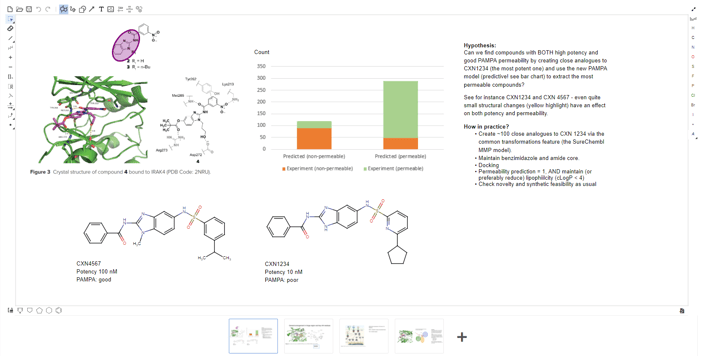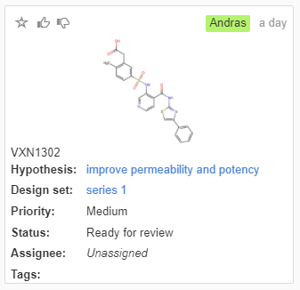Creation of a Scientific Hypothesis - For optimization of drug compounds
Creation of a scientific hypothesis
Scientific hypotheses play a central role in the design and development of new drugs. A rigorous hypothesis is constructed through a systematic analysis of existing data, and serves as a predictive framework for understanding the relationship between a molecule's chemical structure and its biological activity. A well-formulated hypothesis is essential to the success of the drug discovery process, as it guides the design and testing of new compounds and helps to ensure that resources are directed towards the most promising avenues of research.
What defines a good scientific hypothesis?
A good scientific hypothesis facilitating the design of novel drugs…
- Is based on a thorough SAR analysis
- Is easy to understand, allowing for the whole team to contribute and iterate on the initial ideas
- Does not guarantee that the next iteration of designed compounds will always be better, but significantly increases the likelihood that (at least) new knowledge will be generated, that in turn can be used in the next iteration.
- Is supported by predictive models that can be used to filter the suggested compounds to make
- Needs to be safely stored and searchable
Thus, the scientific hypothesis is in the center of the DMTA cycle and facilitates both SAR analysis and making decisions for which compounds to synthesize. (Figure 1).

Figure 1. The scientific hypothesis explains why and how the compounds should be optimized, based on a thorough SAR analysis. Once the hypothesis is in place, virtual compounds can be designed, with the potential of answering the hypothesis. Usually, a virtual iteration and final selection of compounds needs to be made, considering both predicted properties and which compounds are the most feasible to synthesize.
Creation of chemically aware and searchable scientific hypothesis
The creation of chemically aware and searchable scientific hypotheses in drug design further enhances the drug discovery process. A chemically aware hypothesis takes into account the specific chemical characteristics and interactions that are critical for the desired biological activity of a drug molecule. By incorporating chemical knowledge, such as molecular structures, functional groups, and physicochemical properties, the relationship between structure and activity can better understood, leading to more effective drug design strategies.
Chemically aware canvases serve as valuable tools in drug design, allowing researchers to explore and visualize chemical space in a systematic and informed manner. These canvases provide a framework for organizing and analyzing vast libraries of compounds, enabling the identification of key molecular features, functional groups, and chemical motifs that contribute to the desired biological effects.
To ensure the utility of a scientific hypothesis throughout the drug discovery project life cycle, it should be securely stored, easily searchable, and comprehensible to the entire team. Design Hub allows for creation of graphical representations of the hypothesis using a chemically aware canvas (Figure 2):
• Paste pictures, add structures, text, arrows and shapes
• Collect compounds into Design sets
• Attach information of synthetic routes
• Add a dynamic number of pages
• Add any file type as attachments
• Add priorities, status and assignees
Based on the hypothesis, compounds can be generated and prioritized for synthesis (Figure 3).

Figure 2. Example of a hypothesis canvas using pictures, structures and text. Once the hypothesis is shared with the team, the designed compounds can be refined by colleagues, and additional examples added on the same theme. The synthetic routes can be saved and connected to the design sets.

Figure 3. Prioritization of compounds is facilitated by access to novelty searches, computational models and predictions of synthetic feasibility. Scientists in the team can also contribute by commenting or voting.